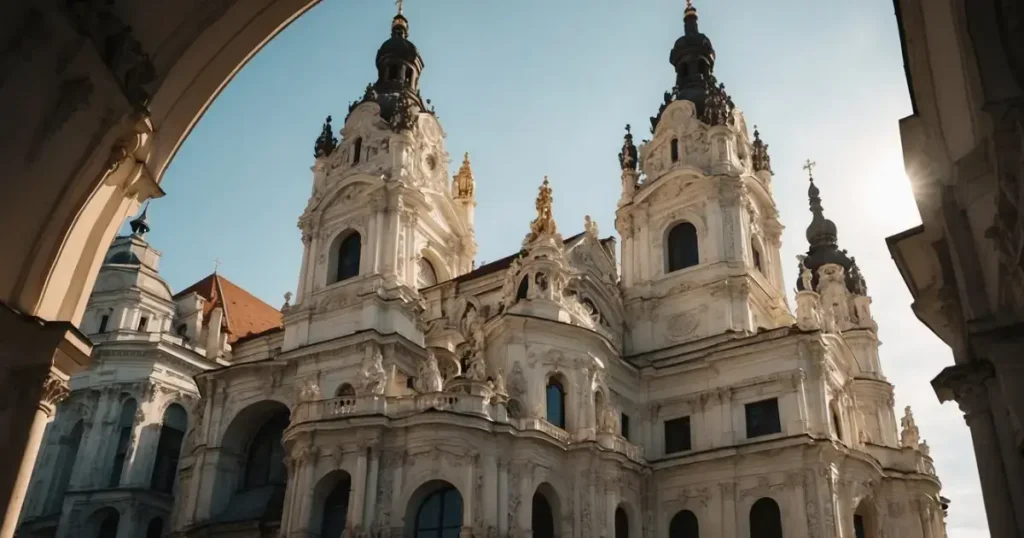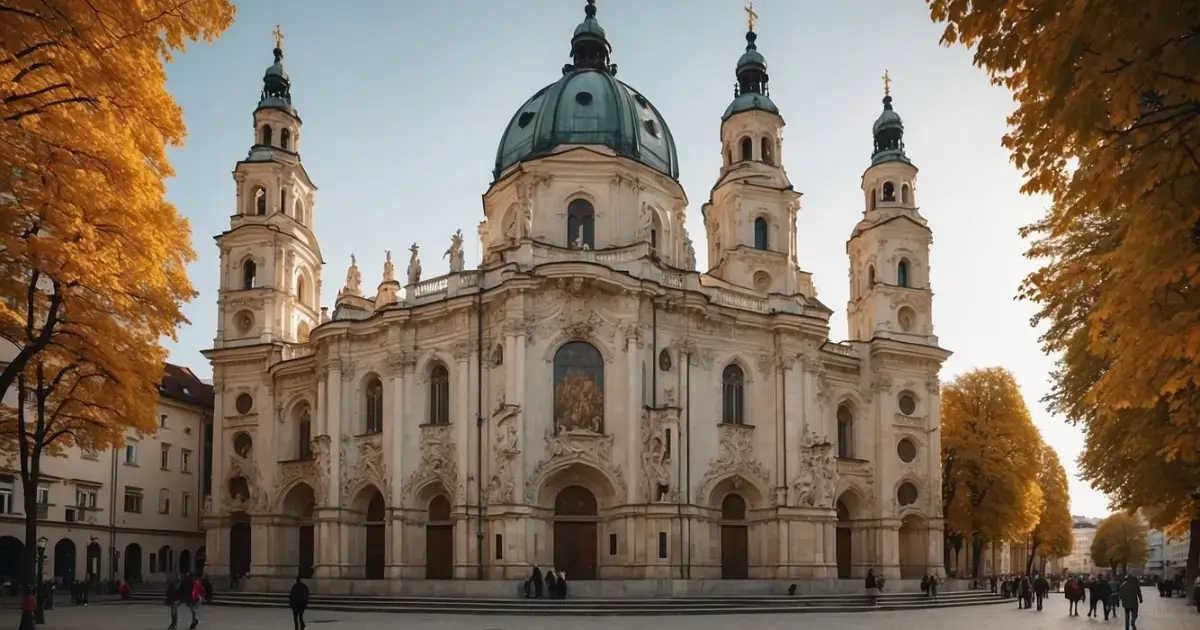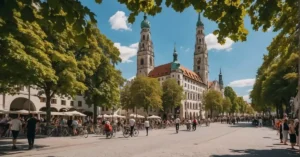Nestled in the heart of Munich, the Asam Church stands as a testament to Baroque artistry and architectural brilliance. Often overlooked by tourists, this hidden gem offers a rich tapestry of history and intricate design. In this blog post, we unveil five fascinating facts about the Asam Church that will leave you in awe of its splendor and significance.
Asam Church Munich

Constructed between 1733 and 1746 by the talented brothers Egid Quirin Asam and Cosmas Damian Asam, this church was initially intended as a private chapel, adding an extra layer of intimacy to its design.
The Asam Church is a must-visit landmark, incredible for its intricate details and the dedication of its creators.
Despite its narrow façade, the interior of Asam Church dazzles with opulent decorations, featuring a blend of gold, silver, and dramatic scenes that rival any grand cathedral.
Its vibrant and elaborate design can completely captivate you, making you feel like you’ve stepped into a different era.
The church’s compact size at just 22 x 8 meters makes it a unique jewel among Munich’s sprawling historic sites.
Beyond its stunning aesthetics, the Asam Church holds a significant historical and cultural value.
Originally meant for personal devotion by the Asam brothers, it was eventually opened to the public, allowing everyone to appreciate its beauty and spiritual ambiance.
Visiting this church not only offers a visual feast but also a glimpse into the rich artistic heritage of Munich.
Don’t miss the chance to explore the exquisite craftsmanship and fascinating history of Asam Church, a true masterpiece in the heart of the city.
Architectural Marvel

The Asam Church in Munich stands as a stunning example of Bavarian Baroque architecture featuring Rococo embellishments.
With masterful frescoes and intricate stucco work, it is a must-visit for any architecture enthusiast.
Baroque Excellence
The Asam Church epitomizes Baroque architecture, distinguished by its exuberant decorative elements and intricate design.
Built between 1733 and 1746 by the Asam brothers, Egid Quirin Asam and Cosmas Damian Asam, it showcases their combined talents in sculpture and painting.
The façade of the church is particularly notable for its grandiose appearance, resembling a court church in its splendor.
Stucco decorations abound, adding depth and texture to the walls and ceilings.
The altar, adorned with gold leaf and intricate carvings, commands attention.
Walk through its richly decorated nave and observe the seamless blend of architectural artistry that captures the essence of the Baroque era.
Rococo Features
The Asamkirche also incorporates Rococo features, characterized by lightness, elegance, and an abundance of ornamental detail.
These elements soften the robust Baroque foundation, resulting in a more playful and flamboyant interior.
Ceiling frescoes framed by decorative stucco enhance the Rococo aesthetic.
The use of pastel colors, intricate patterns, and flowing forms in the interior design exemplifies Rococo’s emphasis on grace and charm.
Votive candles and delicate sculptures add to the whimsical and enchanting atmosphere.
Despite the richness of the details, the designers achieved a sense of harmony and balance, making the space both captivating and reverent.
Each corner and alcove reveals a new visual delight, a testament to the Asam brothers’ artistic vision.
Masterful Frescoes
One of the standout elements of the Asam Church is its ceiling frescoes, painted by Cosmas Damian Asam.
These frescoes are masterpieces of Late Baroque art, showcasing scenes of religious significance with dramatic flair.
The complexity and depth of the paintings draw you in, inviting contemplation and awe.
The central fresco, depicting the life of St. Johann Nepomuk, is particularly mesmerizing.
The use of vivid colors and advanced techniques like illusionistic perspective creates an almost three-dimensional effect, making the figures appear to float above you.
As you gaze upward, the frescoes’ intricate details and emotional intensity reveal themselves.
The artistic prowess displayed in these ceiling frescoes cements the Asam Church’s status as an architectural marvel and a must-see in Munich.
Artistic Highlights

The Asam Church in Munich is a treasure trove of Baroque artistry, featuring intricate sculptures, exquisite altar pieces, and influences from the renowned Bernini.
Sculptural Splendor
When you first enter the Asam Church, the sculptures immediately capture your attention.
Created by Egid Quirin Asam, the sculptures include detailed depictions of saints and religious figures.
The Trinity Figures above the main entrance are particularly impressive, symbolizing the unity of the Father, Son, and Holy Spirit.
Ignaz Günther, a contemporary sculptor, also contributed to the array of works, adding layers of complexity and detail to the overall aesthetic.
The use of light within the church enhances these sculptures, casting dramatic shadows that accentuate their features and evoke a sense of awe.
Altar Artistry
The altar at the Asam Church is a pinnacle of Baroque artistry.
Designed with spiral columns reminiscent of Bernini columns, the altar is adorned with intricate carvings and rich gold leaf.
Cosmas Damian Asam’s paintings, depicting scenes from the Life of Saint Nepomuk, add a vibrant narrative to the altar’s grandeur.
Numerous Trinity Figures and other religious iconographies are prominently featured, capturing the spiritual essence of the church.
The clever use of light not only highlights the details but also creates a divine atmosphere that enhances your spiritual experience.
Bernini’s Influence
Lorenzo Bernini’s influence on the Asam Church is unmistakable.
Known for his mastery in combining architecture, sculpture, and painting, Bernini’s style is reflected in the church’s design.
The Bernini columns in the altar and various sculptural elements draw clear inspiration from his works.
You can see Bernini’s impact in the church’s architectural layout and the dynamic poses of the sculptures.
This blend of art forms elevates the church’s aesthetic, making it a remarkable example of Late Baroque architecture.
The interplay of light and shadow within the sculpture work further enhances this dramatic effect.
Historical Significance

Asam Church in Munich is a vital piece of Baroque architecture, reflecting both the religious fervor and the artistic ambitions of its creators, the Asam Brothers. This section explores its dual role as a private and public place of worship, and the enduring legacy of its creators.
Religious and Social Role
Asam Church, officially known as St. John of Nepomuk, holds significant religious and social importance in Munich.
Originally conceived as a private church by the Asam Brothers, its purpose evolved to serve the public due to high demand. This shift embodies the intersection of personal devotion and communal influence in 18th-century Bavaria.
Located on Sendlinger Straße, the church has been a cornerstone of the local community.
It has facilitated worship and provided a place for prayer and reflection. Despite its small size, it has drawn countless visitors, reinforcing its status as a cherished place of worship in Southern Germany.
The Asam Brothers’ Legacy
The Asam Brothers, Egid Quirin and Cosmas Damian Asam, left an indelible mark on Munich’s architectural landscape. They built Asam Church between 1733 and 1746, embedding their creative genius in every corner.
The church, part of the Asamhaus ensemble, showcases their talent in Late Baroque art and architecture.
Their decision to turn their private chapel into a public church speaks volumes about their dedication to the community. The church’s stunning interior, from its intricate frescoes to its detailed sculptures, remains a testament to their legacy.
Today, it stands not just as a building, but as a symbol of their enduring impact on the cultural and religious fabric of Bavaria.
Our Opinion about
The Asam Church Munich is a real landmark of the city of Munich. It can be found on almost every picture postcard of the city. If you want to get to know this imposing building, you should definitely plan a visit to the church. Although you can also get a good impression of the building from the outside, a visit inside is definitely worth the money. You will not regret it.
FAQ about
What is the history of Asam Church in Munich?
Asam Church, also known as St. Johann Nepomuk, was built between 1733 and 1746 by the Asam brothers, Egid Quirin and Cosmas Damian, as a private chapel. It showcases the late Baroque style and is renowned for its elaborate interior.
Is there an entrance fee to visit Asam Church?
No, there is no entrance fee to visit Asam Church. It is free to the public, although donations are appreciated to help with the church’s maintenance and preservation.
What are the visiting hours for Asam Church?
Asam Church is generally open to visitors daily from 9:00 AM to 6:00 PM. However, hours may vary on holidays and special occasions, so it’s advisable to check ahead before planning your visit.
Discover more hidden gems like Asam Church Munich! Follow us on Pinterest for travel inspiration or exclusive updates.






